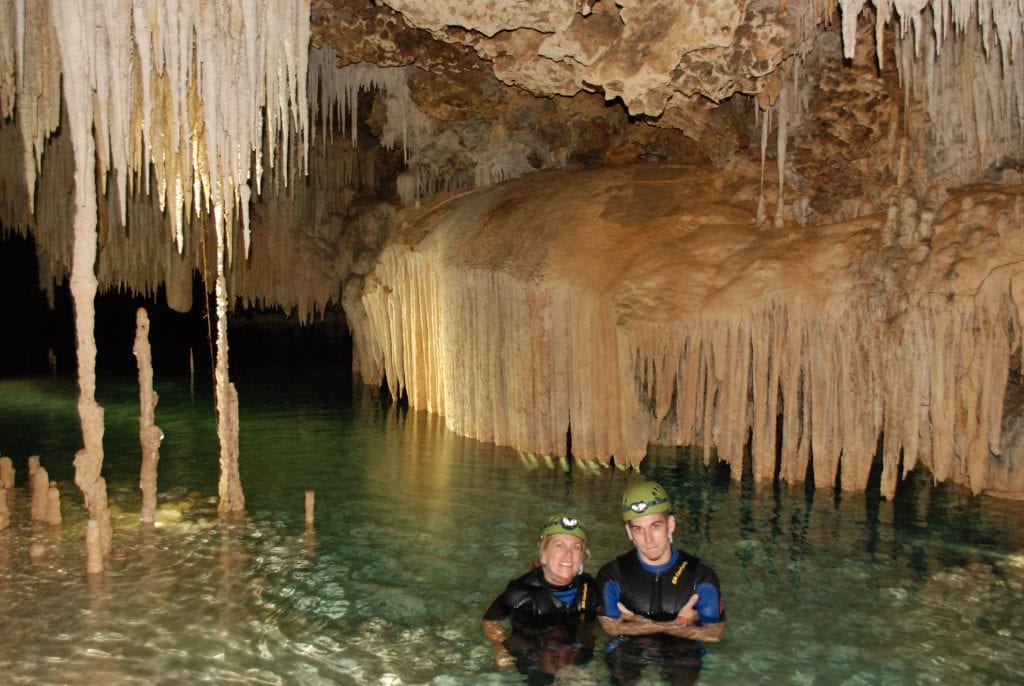
PHOTO BY MIMI SLAWOFF
About 65 feet underground in Mexico’s Yucatán Peninsula, my family and I recently swam in a cold river flowing through one of the region’s many cenotes – collapsed portions of caves – considered sacred by the Maya people.
As we navigated the cave single file through narrow passages, our guide explained that to the Maya, the cenotes are an entryway to the underworld, a place to communicate with their gods. At the end of our tour, we sat in a circle in total darkness for two minutes; the only sound was of dripping water for this rather spiritual experience. It was a serene way to end an exhilarating tour through one of the Yucatán’s mystical attractions.
Cenote tours are among several ways to learn about the fascinating Maya culture in the Yucatán, an area in southeastern Mexico that separates the Caribbean Sea from the Gulf of Mexico. All-inclusive oceanfront resorts sit on sandy beaches in the popular tourist districts of Cancún, Playa del Carmen and Riviera Maya.
We’ve stayed at a few resorts from budget to posh over the years, but especially enjoy Club Med Cancún Yucatán for its family activities, beaches and prime location at the tip of the Riviera Maya. The Yucatán-themed resort offers free salsa dance lessons, cooking demonstrations and several cultural and adventure tours for a fee.
Maya ecological and archeological sites
Our introduction to Maya culture was a guided excursion to Boca del Puma, an ecological reserve in the jungle. We rode mountain bikes on a gravel road to Chickeros, a rustic village where sapodilla trees grow in the rainforest. On a walking tour through the steamy jungle, we learned that local farmers collect the sap to produce organic chewing gum, a tradition tracing back to the Maya. Sale of the chewing gum allows today’s Maya farmers to preserve their forests while earning income.
Historically, the Maya were resourceful engineers who built com-plex cities from stone in areas conducive to trading. One such site is at the Sian Ka’an Biosphere Reserve and UNESCO World Heritage Site about two hours south of Cancún. Sian Ka’an (Mayan for “where the sky is born”) is home to thousands of species of flora and fauna, and lagoons, and is one of the oldest Maya settlements.

PHOTO BY MIMI SLAWOFF
Our tour started with a nature walk through a lush jungle humming with the sound of tropical birds. A path leads to the Muyil Maya ruins, a 55-foot pyramid in surprisingly good condition. Muyil (also called Chunyaxché) dates back to about 300 B.C. In time, the Maya excavated two canals to transport cotton, jade, honey and other goods. We rode through these same canals in small boats, past mangroves and to a shimmering lagoon, where we jumped into the refreshing water.
Nearby, on a cliff above the Caribbean Sea, is Tulum, one of the most popular archeological sites. To beat the crowds and heat, we arrived early to admire the approximately 60 well-preserved lime-stone structures. What makes Tulum unique is the wall around the city and its location on the coast. Tulum thrived between the 13th and 15th centuries, trading in turquoise and jade.
Navigating the Yucatán’s natural waterways
Throughout the Yucatán are thousands of cenotes in various shapes and sizes, some dry but most connected with flowing underground rivers. The word cenote comes from the Maya word “dzonot,” translated as “natural well,” and they were sometimes used by the Maya for sacrificial offerings. Scientists have found skeletons in some cenotes.
Guided tours of cenotes typically include a walk through a jungle, a swim through a cave and a regional lunch, which may include empanadas and fruit. So far, my favorite cenote tour is at Rio Secreto (www.riosecreto.com).
On this 90-minute underground cave tour, we wore wetsuits and water shoes and strapped on life jackets and hardhats with headlamps. Our guide explained that we’d walk through portions of the river and then doggy paddle without splashing when it got deep.
At times our group held hands to form a human chain for balance as our guide led us through majestic rooms draped with thousands of stalactites and stalagmites.

At one point, our guide sat down with us. “On the count of three, turn off your headlamps,” he requested. “Please, no talking for two minutes. Then, when we leave the cenote, everything will look so colorful outside.” Sure enough, with heightened senses, we climbed out to a vibrant world of color and sound.
On a visit with friends to the Yucatán in May, we booked a Turtles & Cenotes Tour with Ocean Tours Mexico (www.oceantoursmexico.com). It was my first visit to the small town of Akumal (Mayan for “land of turtles”), where the blue waters of the bay blend seamlessly with the sky.
Our guide, JP, gave us a crash course on various turtle species and the importance of protecting reefs and natural areas. Akumal’s calm waters make it ideal for snorkeling and sighting turtles. Afterward, we walked through a subtropical rainforest to two cenotes – one dry and the second filled nearly to the brim with recent rainwater. In parts of the cave, we swam through deep water close to the cave’s ceiling, and a woman in our group panicked when we saw clusters of bats. But JP was reassuring and led us out safely.
Unlike guided tours, Xel-Ha (Mayan for “where the water is born”) is a natural water park that offers both laid-back and thrilling experiences at your own pace. The all-inclusive Xel-Ha (www.xelha.com) offers classic Yucatán activities in one park. These include snorkeling, floating on tubes through a mangrove and swimming in coves and a small cenote. There’s even cliff jumping.
My son Michael jumped off a cliff to the river about 25 feet below. “Xel-Ha is still one of my most favorite places in the world,” he says.

























